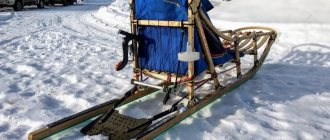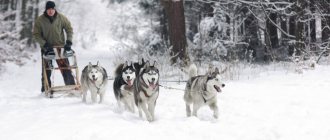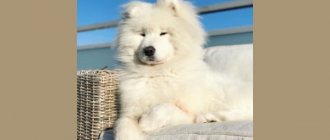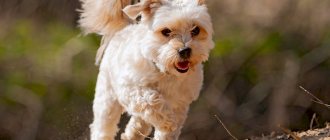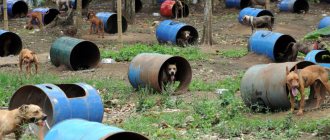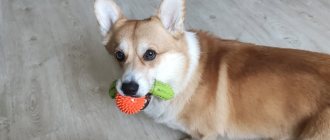The Volokushi probably invented the wheel before. Sledges are a kind of improved version of this device. Quite simply, a sledge can be described as follows: a wooden flooring on a pair of long skis, tied to dogs or deer. It was these animals that were the main draft force among the indigenous peoples of the North.
Sleds for dogs, as well as for reindeer, were widely used in the everyday life of the Chukchi, Eskimos, and Evenks. They carried simple household utensils, roamed with herds of reindeer across the tundra, and were used for hunting, fishing, and even in warfare.
Dog transport is indispensable in conditions of total off-road conditions. Dogs, eating local food (fish, meat), having amazing endurance and unpretentiousness to the harsh conditions of the North, have no competitors in draft work. A dog sled can travel up to 200 km in a day. With a load of up to 500 kg, a team of ten dogs can travel up to 80 km daily for several days in a row.
Reindeer cannot compete with them in places where reindeer moss (their main food) does not grow, and in the coastal zone - it is very difficult to move on ice on them.
To control a team of reindeer, mushers used an ostol, a special pole for controlling sleds. With its help, you can slow down the sled, turn it, or poke a lagging or lazy animal. At parking lots, the ostol was stuck between the crossbars of the sled, using it as a hand brake.
A pole was also used for dogs to control the sleds, but with a slightly improved design. Several metal rings were attached to its upper part. By jingling them, the musher gave direction to the team, turning it in the right direction.
Race
Difficult survival conditions in the far north and hard work required positive emotions. Dog sled racing has become a great way to escape from daily worries and see whose dogs are stronger and more resilient.
The history of dog racing goes back hundreds of years, but it was known only to residents of Canada, the USA and Russia. The gold rush gave them massive popularity and prevalence among the entire population of the Earth. In the extremely difficult conditions of gold mining, only dogs were reliable draft force. The lives of a huge number of people depended on their endurance and ability to pull heavy loads over long distances.
A strong dog team was worth its weight in gold and was the pride of its owner. Not all of these animals are capable of being ridden. The best breeds for racing are Siberian Husky, Samoyed, Eskimo Laika, Alaskan Malamute, Greenlandic, Chukchi sled dogs and their crosses.
History of the development of sled sport
One of the first mentions of racing occurs in 1850. The route between the cities of Winnipeg and Saint-Paul was chosen as the venue for the competition. And the next event, which left documentary evidence of its occurrence, was held in 1886 in the same American city of Saint-Paul.
History shows that the true development of this sport occurred during the Gold Rush. It was during this period that prospectors actively conquered the vastness of the White Desert. The mines were located in remote parts of the country, so the use of dog sleds to move people and equipment became the most affordable and effective solution.
Within a short period of time, a special class of drivers was formed, called mushers. Their main task was to deliver miners and food to remote mines.
And already in 1907, the first real competitions between the best mushers and their teams were held in the city of Nome. One of the significant figures in the competition was its founder, Scotty Allen. But the silver medalist of the 1932 Winter Games, Leonard Sepalla, was no less popular at that time.
Experts say that one of the reasons for such a loud popularity of this sport in the United States was the story of the dog Bolto. He was the leader of the team, which, under the leadership of musher Gunnar Kaasen, accomplished a real feat.
The musher and his dogs were able to deliver diphtheria serum during the epidemic. The team managed to fight its way through a severe snowstorm and its leader became a hero of the United States.
Gradually, sledding sport migrated from North America to Norway, and then to other European countries. An expedition led by Rasmussen and Nansen played an important role in the popularization of such races.
They used dogs to transport cargo and move people across the expanses of the North. Fans of racing began to unite in special clubs only in the seventies of the twentieth century.
In the Soviet Union, competitions were held at the level of the northern regions and the media poorly covered this event. But already in 1990 a race called “Beringia” took place. Its length was 250 km. And just a year later, the dream of sports fans came true and an incredibly long race was held.
Its route passed between two settlements and ran from Nome and Anadyr. In 2014, the Russian Sled Sports Federation was created, uniting scattered amateur clubs under its wing.
Sleds for dogs
An equally important element of such competitions is a special racing sled. Sleds for dogs can be purchased in specialized stores along with all the equipment for animals. They differ in design, material of manufacture, weight, and dimensions. But for all models and types of racing sleds there are mandatory elements:
- runners - run parallel to the ground at a slight angle, which gives them stability;
- arc or ram - the driver holds on to it while riding;
- legs-spears - connected by crossbars;
- flooring for cargo or passengers.
A real musher (dog driver) makes sleds with his own hands. Size and design depend on the purpose and type of winter racing:
- sprint class, short-distance speed racing;
- medium distances – up to 500 km;
- for long distances - over 500 km;
- multi-stage race - may consist of several types of distances;
- cargo - luggage transport competitions;
- with terrain orientation - a team of two people passes a route with checkpoints.
Sleds can be designed for long or short distances, for one dog or a team of up to 16 dogs.
Popular competitions
For the information of athletes who want to take part in modern races, we provide information about the time and place of their holding. The most popular include:
- "Following the trail of yellow leaves." Venue of the Moscow Region, Volkusha quarry, October. Dryland competition type. The mushers cannot be younger than 12 years old. For dogs, the age limit is 12 months or older.
- "Silver Boat". The venue was the Kostroma region. The nearby village of Nikolskoye awaits athletes in early December. The age of participants is from 9 years in different groups. Competitions are held in two areas: skyjoring and sledding. Participants can choose a distance of any length, starting from 500m. You can also try your hand at a 5 km long track, and for serious mushers there is a 20 km track. All dog breeds are welcome, including mongrels.
- "Through the land of Sampo." January, Karelia. Professional racing. Dogs of any breed are allowed to participate; the musher cannot be under 18 years of age. Competitions are held in two areas: harness racing and skyjoring. Athletes can choose a distance of 6 km, and for the more experienced and well-prepared, the organizers offer a choice of a length of 10 or 40 km;
- "Northern Hope". Chukotka, sleds. The age category for mushers is 18+, and for dogs the age limit is under 18 months. The length of the route is 500 km;
- "Beringia". Chukotka. The length of the route is 1500 km. Sled. The age category of mushers is 18+; the dog cannot be younger than 18 months.
Most regions have equipped trails designed for regular exercise. They allow you to hone the skills of a musher, as well as instill in dogs the necessary skills and increase the level of endurance.
Methods of harnessing dogs
There are two types of dog harnesses: fan and train. The train harness is considered more ancient and convenient. Dogs are fastened to a long central pull-belt. There are two ways: dogs are tied in pairs or alternately in a herringbone pattern. With this method, animals are tied on short straps at the same distance from each other, in turn from the right and left.
With a train harness, the leaders are placed in front. As a rule, these are strong dogs that can make their way in deep snow. The convenience of such a harness is that you can quickly replace a tired front pair and continue moving without losing speed. At races, dogs are harnessed in a train.
The fan version of the harness involves placing the animals in an arc relative to the sled. This also has its own nuances, a fan can happen:
- full – dogs are located on the same line;
- along a slightly curved arc;
- ledge - dogs are harnessed in the form of a wedge.
With different versions of the fan harness, the location of the leaders can be in the center or on the sides. An odd number of dogs are harnessed. This method is not used for racing.
Owners' opinions
I live in the private sector. Our neighbors have two Caucasians. They have booths, but they move around the territory freely, behave decently and do not bark at everyone. However, one day they forgot to close the gate, and one of the dogs went for a walk outside the site. At that moment I was passing by and experienced extreme stress. Fortunately, the Caucasian was calm as a boa constrictor. He soon returned home, where he felt quite comfortable. My great-aunt also had a chain dog named Bobik. He responsibly guarded the apple orchard, but every evening he ran freely around the yard. Unfortunately, not everyone is so lucky. I remember another neighbor’s dog (short-haired), who spent most of the time just standing at the booth and howling hoarsely in anguish. Towards the end of her life, she lost a lot of weight, and her paws weakened, making them look half-bent. They never let her off the chain, didn’t communicate with her, and didn’t walk her. Local dogs, constantly sitting in enclosures, also suffer from idleness and physical inactivity, so I consider the best option to be the free movement of the animal around the site, the use of a checkpoint at night and the presence of a warm booth in case of bad weather
But the most important thing is the attention and care of the owner
I have a huge German Shepherd living in my yard. I keep him on a chain, because he has a very intimidating appearance, and if he runs freely around the yard during the day, even passers-by will walk around my yard 200 meters away. That’s why I only let my guard run around at night, when he won’t scare anyone, but the security is excellent. He is happy to run around and I sleep peacefully, knowing that no “night guest” will get into my yard. For a full-fledged lifestyle, the dog should not only rest lying on its side, but also rest actively, that is, run and jump freely.
In my opinion, a chain and an enclosure are the same restriction of freedom. There is a chain that slides freely along a wire stretched over a large area (this is called a block leash), so this is much better than an enclosure, in my opinion. But in any of these cases, the dog needs a walk - to exercise, lose energy, and play. In this case, the temporary restriction will not be a prison. And if it’s chained for life, it’s a nightmare.
Video: the opinion of the owner of a training center about keeping dogs on a chain
A dog sitting on a chain for protection should not be a powerless prisoner. He remains a family member and a pet for whom you are responsible.
Provide your dog with competent care, walk, communicate, pay attention, let him off the leash during off-duty hours. Then she will feel needed and responsibly perform the duties of a security guard.
Modern sledges
Progress has long since stepped forward, but on the snowy plains sledges are still a popular means of transport. Dogs were replaced by snowmobiles. The sledges themselves have been improved. These are specialized models of towbars designed for different purposes. For their production, the most modern materials and advanced technologies are used.
Snowmobiles have firmly entered the lives of today's hunters, fishermen, tourists, participants in various expeditions, outdoor enthusiasts and ordinary residents of northern latitudes. A good rest or work requires some kind of equipment. To transport it, they did not invent the bicycle, but improved the ancient means of transportation - the sledge.
How to start training
Systematic and regular training is the key to success. And racing with sled dogs was no exception. Great attention should be paid to the coordinated work of the dog and the driver. And the balanced and nutritious diet of the dog, as well as the process of bringing it into optimal physical shape.
The main part of the competition takes place in the cold season. But athletes carry out intensive training all year round, with the exception of the hot period. All preparation can be divided into 3 key periods:
- Leisure. Lasts from May to August. This is the ideal period for your pet to rest. Swimming, long walks and moderate exercise help maintain the dog’s tone;
- Workout. September - January. During this period, the skills and exercises necessary to participate in the race are developed;
- Performances. The organizers choose the period from January to March-April for them. At this stage, participants must show their achievements and demonstrate their acquired skills to the maximum extent possible.
- The preparation of equipment deserves special attention. For the dog, you should individually make ammunition, and also train the animals to work with a certain type of equipment. This will make it easier to complete the distance.
You may also be interested in our article: Training and training of hunting dogs
The training program is developed by the musher or his trainer. All data on weather and loads are recorded, and the likelihood of injury to competition participants is assessed. The animals and the musher must be in perfect shape before the start of the competition and the dogs must unquestioningly obey all commands.
This is important: you can start training in any region. It is enough to contact the kennel club and experienced breeders will tell you how and where to start the training process.
Volokushi
Volokushi is the simplest and most affordable model. It looks like a deep trough with a trailed drawbar for a snowmobile. In addition to low cost, drags have the following advantages:
- very simple design;
- little weight;
— they practically do not freeze in slush;
— they are convenient for storing luggage;
- have a low center of gravity, which prevents rollovers;
- float on water.
There are also significant drawbacks, the most important of which is the absolute lack of comfortable conditions for transporting passengers. Their entire area is in contact with the surface of the earth, so there is no shock absorber suspension here. Any unevenness, stone, log or stump will significantly hit the drag; the plastic may not withstand such loads and may crack. Because of this, they are preferable for use in snow.
Another frequent breakdown is the destruction of the drawbar due to a strong impact, for example against a tree. Low carrying capacity, getting the load wet when transporting by water or slush, and instability on slopes can also be considered negative characteristics of the drag.
Reliable carbines for fishing with Aliexpress
If the article “The Weakest Link” has already been read, then the likelihood of purchasing fishing accessories from a Chinese manufacturer automatically disappears. It was the same for me. However, as it turned out later, not everything is so bad. All you have to do is spend some money, order several models from “real” Chinese manufacturers and test them while fishing.
Just for fun, fasteners from 3 different companies were ordered from Aliexpress. He equipped leashes made of fluorine and tungsten with carabiners. Some people didn’t like the bend of the toe. It was inconvenient to change wobblers. Another questioned the quality of the wire. I had to use pliers to press the bracket. There have been no problems with only one model so far.
The name of the office is "Paxipa". Engaged in the sale of baits and equipment for spinning and carp fishing. By the way, they sell pretty good offset hooks.
NHNCH
There is no such thing as too much information
Cargo sleds
Cargo sleds, unlike drag sleds, are equipped with skis to glide along the surface. Often models are equipped with shock absorbers. Advantages:
— large load capacity;
— wide-set skis provide stability, and the presence of skates prevents them from turning over on the slopes;
- more comfortable transportation of passengers compared to drags;
— water, even if it gets on the sled, does not accumulate on it;
— sleigh boxes ensure complete safety of cargo and easy luggage stowage.
At the same time, there are also some problematic aspects, first of all, the large weight of the sled itself. When transporting large or long loads, luggage should be carefully stowed, taking into account the optimal load balance over the entire length of the sled. Metal parts freeze over, causing additional trouble to their owners.
Carbine shape
One of the most versatile forms of carabiner is the hook with a small lever and swivel. This is the classic model that is most common. Provided the correct size is selected, it will fit almost any pet.
Separately, it is worth mentioning the so-called climbing carabiner, which is a link with a twist-on coupling. This type of carabiner is suitable for particularly active large dogs, as it is characterized by increased reliability and difficulty in removal. However, for a climbing carabiner, you must separately purchase a swivel that will prevent the leash from twisting.
The carabiner can be purchased separately or together with the collar. Choose ammunition according to its purpose. A particularly strong carabiner is needed during training and at shows - in situations where it is necessary to control the dog. In everyday life, you can use simpler and lighter models.
Small, elegant fittings that will not weigh down the design of the collar and leash will suit them.
Photos:
Passenger sleds
Passenger sleds for snowmobiles can be closed or open, with a capacity of 2 to 8 people. There are small ones, in the form of a plastic capsule with a luggage compartment, designed for 1-2 passengers.
An upgraded comfort class option is available. They comfortably accommodate four adults, comfortably seated on soft sofas. The level of comfort and equipment depends on the brand of the manufacturer and the class of the sled. There are also open sleds for transporting fishermen, hunters or tourists.
Terminology
Race – a competition program in a specified discipline or class.
Race – passing the distance.
The competition area is the place where all the facilities are located: parking, stake-out (place where dogs are placed), starting and finishing areas, area where judges and service personnel are located, spectator area, and the tracks themselves.
Team - dogs harnessed to a sledge, pulka, etc.
The driver is the driver of the team.
Handler is the driver’s assistant at the start, finish, and checkpoints.
Equipment – items of clothing, equipment, ammunition.
Free dog (team) – an animal (team) without a leash on the competition territory.
Homemade
A huge number of people make sleds with their own hands. Firstly, it's cheaper. Secondly, you can make highly specialized sleds for a specific task. It depends only on the experience and skill of the master how suitable the sled he makes is for transporting heavy luggage or comfortable travel for people. And most importantly, homemade sleds are an opportunity to bring interesting developments and your own inventions to life.
When choosing sleds for a snowmobile, you should consider not only the purpose of their use, but also the conditions in which the sled will have to be used. Each design has its pros and cons. There is no universal option for all occasions.
In snowy areas, plastic models are appropriate. Low temperatures require high quality plastic. Rocky areas require the use of metal skids, transportation of people requires the presence of shock absorbers, it is convenient to transport small loads on short drags, and for heavy and bulky luggage, use cargo sleds.
Mechanical “smaller brothers”
You can also make a motorized dog with your own hands. The huge demand for light motorized towing vehicles is due to the compact size of the device and excellent cross-country ability. The main element for making a motorized dog with your own hands is the engine, for example, the Sh-58 moped motor, designed for manual switching. Homemade motorized dogs are universal. The controls of a motorized towing vehicle are also important, and a steering wheel with built-in controls is best suited here, namely the gearbox switch, gas handle and clutch from a motorcycle. The supporting structure of a motorized dog can be a welded frame consisting of pipes of various diameters.

